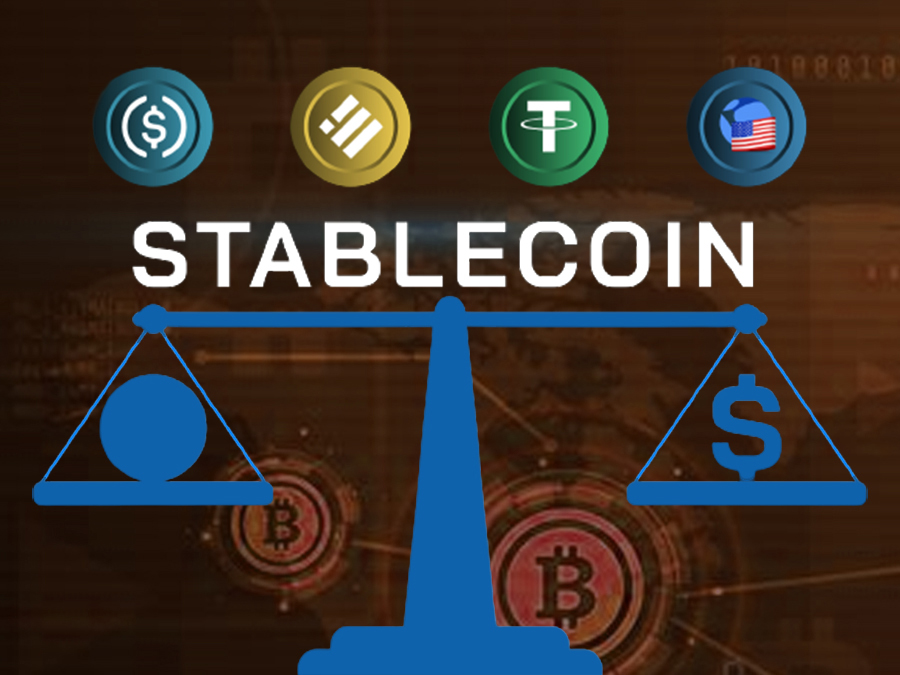What are stablecoins? The Importance and Classification of Stablecoins (2022)
What are stablecoins? Why are stablecoins important in crypto? How many types of Stablecoins are there? Learn all about stablecoins here!

Cryptocurrencies are known for their huge volatility in the short and long term. Although DeFi promises to take Crypto to another level from cryptocurrency to crypto assets in a new economy, most of them are often looked down upon for looking like speculative assets due to their highly volatile prices. Stablecoins promise to be a potential piece to connect the crypto space with the traditional financial market through its “stable” character.
However, when it comes to Stablecoins, most of you think of Tether (USDT) and think that Stablecoin is a cryptocurrency that is converted 1:1 by the US Dollar. But that's not true! There are many different types of stablecoins in the Crypto market, and USDT is just one of dozens of stablecoins currently on the market.
In this article, FoxCryptoNews will provide you with information including:
- What is stablecoin?
- How many types of Stablecoins are there? How does the price balance mechanism of Stablecoins work?
- Are Stablecoins Trending?
What are stablecoins?
Stablecoin is a cryptocurrency designed with the aim of minimizing the impact of price volatility by fixing it to a more stable asset such as fiat money. goods (gold, silver, etc.), or maybe another cryptocurrency.
Stablecoins take advantage of blockchain features and peer-to-peer value transfer, while users are not subject to high volatility like from cryptocurrencies other.
What problems do stablecoins solve in Crypto?
Stablecoins appeared to solve the biggest problem in the current Crypto market, which is volatility.
- For traders or investors, they can transfer assets to Stablecoins to avoid the volatility of cryptocurrency without necessarily changing to Fiat.
- For shops, it is difficult for any company to accept payment in 1 type of Crypto with a fluctuation of 20-30% in value in a short time. This, in turn, has made the widespread adoption of cryptocurrencies so much more difficult.
Thus, it can be seen that Stablecoins are important as a bridge between the electronic market and the traditional financial market. Converting from Fiat to crypto is much easier with the advent of Stablecoins.
As Erik Voorhees, CEO of Shapeshift commented:
“Stablecoins are important in the same way that a bridge is important. You may not care much about the bridge, but without it, the beautiful land beyond is much harder to get to”.

Why are stablecoins important to crypto?
Most of us don't feel comfortable with loss, which is exaggerated when crypto is highly volatile and highly speculative, token price can drop several tens of percent within a week, for For many people, this is very difficult to accept.
For example, you win a few trades and decide to take profits out of BTC, about a week later, you lock BTC into EUR and find that the amount of EUR you put in and out has no difference. deviated. How do you feel?
Stablecoins segregate high risk/high return of crypto from the frequent fluctuations of crypto assets, the "stable" character, making Stablecoins a more suitable cryptocurrency for storage and as a medium of exchange for price. Value.
Stablecoin classification
There are currently 4 types of Stablecoins in all, including:
- Fiat-backed Stablecoins.
- Commodity-backed Stablecoins.
- Crypto-backed Stablecoins.
- Algorithmic Stablecoins.
In particular, Algorithmic Stablecoin can also be divided into 3 types: Rebase, Seignorage, and Fractional.

Fiat-backed Stablecoin
Stablecoins of this type on the market are USDC or USDT, they use the US dollar or equivalent highly liquid assets as a reserve. 1 USDC minted on-chain will have 1 US dollar or equivalent asset in reserve.

This type of stablecoin in the market is also known as Custodial or Centralized Stablecoins, because they require users to trust custodians, not custodians. smart contract on-chain.
Despite concerns around centralization, currently, USDC and USDT are the two most used stablecoins in DeFi.
Commodity-backed Stablecoin
Commodity-backed Stablecoin works similarly to Fiat-backed Stablecoin. The difference lies in its peg value:
- Fiat-backed Stablecoins whose pegs are Fiat currencies, most typically the US dollar.
- Commodity-backed Stablecoins with pegs are precious metals, most notably gold and silver.
Until now (May 18, 2022), most Commodity-backed Stablecoins take the value of gold as a peg. Tether Gold (XAUT) and PAX Gold (PAXG) are currently the 2 largest stablecoins in this segment.
Crypto-backed Stablecoin
Crypto-backed Stablecoin is a type of Stablecoin that uses crypto assets directly as collateral for its value.
DAI is the most representative stablecoin of its kind on the market. Basically, for every DAI minted in the market, there will be $1.5 - 1.6 worth of assets collateralized in the Maker Vault.
If the value of the collateral falls below the minimum threshold (usually 150%), the Vault will be liquidated, reducing the supply to bring the DAI price back to the peg price.
Over-collateralized is a pretty good approach in the context of Crypto being a relatively low-liquidity market, this approach helps DAI can always be Backed by a larger amount of assets. DAI Minted out. The limitation of this approach is that it is difficult to scale.

Algorithmic Stablecoins
This is an algorithmic Stablecoin, for example Basis Cash.
In which, the stablecoin of the system is BAC issued without reserve of collateral. Instead, value is fully preserved by algorithms that shrink and expand the supply when the BAC price is above and below the peg. This model assumes that parties are actively involved in maintaining the price of BAC to earn relevant incentives.
Example of how Basis Cash works:
Basis cash has 3 Tokens BAC, BAS, BAB:
BAC is Stablecoin - it is Peg for 1$ and has a stable mechanism daily.
When BAC trades over 1$:
- BAS Holder can Stake BAS ⇒ Earn Inflation (Earn BAC) according to the formula:
- (Your BAS/Circulating Supply BAS) * Total Supply BAC * (TWAP BAC Price) - first).
- BAS Holder earns BAC Free, so according to the model theory, they will sell to the market to make a profit ⇒ Selling pressure pushes BAC price down to 1$.
When BAC trades below 1$:
- Holder BAC can use BAC to buy BAB at the rate BAB = (BAC Price)^2.
- BAB does not expire and can be exchanged when the price of BAC is greater than 1$.
- For example, when a user is holding 10 BAC and the price of each BAC is $0.8, then the user can use 10 BAC to buy 15,625 BAB.
- Suppose, 3 days after BAC price increase to 1$, user can exchange 15.625 BAB = 15.625 BAC and sell BAC on DEX and earn almost 50% profit from his 10 BAC.
According to this pattern, buying pressure pushes BAC price to $1.
Not only Basic Cash, there are many other algorithmic stablecoins on the market with many novel operating models. In general, there are 3 main models of price retention:
- Rebase: Holds the token price by adjusting the number of tokens in circulation. If the token price rises above $1, the number of tokens in the holder's wallet will automatically increase and vice versa. Typical tokens: AMPL, BASE.
- Seigniorage: Use multiple tokens to keep the price of the original Stablecoin. Based on the price difference between them, traders will arbitrage to bring the Stablecoin price to the peg. Typical tokens: UST, BAS, FEI.
- Fractional: Combination of Fiat-backed Stablecoin and Seignorage Stablecoin. Typical token: FXS.

Stablecoin investment: Will Stablecoins become mainstream?
Before talking about the Stablecoin trend, let's reiterate a little bit about the formation and development of the Stablecoin ecosystem from 2013 until now.
As you can see in the chart below, Stablecoins really exploded in 2018 with more than 36 consecutive Stablecoin projects hitting the market, accounting for more than 54% of the total current Stablecoins.

Besides, Stablecoins will continue to thrive with the participation of big players like JPM Coin of J.P. Morgan bank, Libra of Facebook.

Along with that, Stablecoins allow us to safely generate passive income, similar to bank savings. Here are a few ways to make a profit with Stablecoins.
Yield Farming
Yield Farming is the use of a pair of tokens to provide liquidity, thereby receiving rewards from the platform. This token pair can be Stablecoin-Stablecoin or Stablecoin-Altcoin. The second option offers a higher return, but means a higher risk because Impermanent Loss (temporary loss) may occur.
Some platforms allow Stablecoin farming:
- Curve Finance:3 - 35% APY.
- Convex Finance:2 - 28% APY.
- Saber Finance:3 - 20% APY.
- Ellipsis Finance:4-70% APY.
Reference: How does Yield Farming work?
Staking
Staking is a safer way to generate profits than Yield Farming, because staking only requires the supply of 1 type of token instead of 2. Of course, the interest rate is also certain. will be lower.
Some platforms that allow staking Stablecoins:
- Binance:3 - 13% APY.
- Yearn Finance:2 - 22% APY.
- Stargate Finance:4-6% APY.
More references: The secret to optimizing profits when Staking Coin
Lending
Lending is to lend Stablecoins. Basically, providing Stablecoins via Lending is the same as Staking.
Some platforms allow to lend Stablecoins:
- Aave:2 - 7% APY.
- Compound:1 - 2% APY.
Learn more: Parameters to pay attention to in Lending
Where to buy Stablecoins?
Via
CEX exchange: All CEXs support the purchase and sale of Stablecoins through many ways such as using crypto assets, or with money in a bank card.
Via DEX: There are DEXs created with the main purpose of supporting the exchange of Stablecoins with low slippage, such as Curve Finance, Ellipsis , or Mobius.
Direct Mint: Instead of buying Stablecoins, you can also mint them directly using collateral. Projects supporting this work include MakerDAO (DAI), Abracadabra Money (MIM),...
Conclusion
I will summarize some of the main points of the article as follows:
The most important feature of Stablecoins is to separate the high risk/high return characteristic of crypto from the frequent volatility of crypto assets, making it Stablecoins become more suitable cryptocurrency for storing and as a medium of exchange of value.
We have 4 types of Stablecoins with different characteristics:
- Fiat-backed Stablecoin: USDC and USDT are the 2 most used Stablecoins in DeFi.
- Commodity-backed Stablecoin: Works similar to Fiat-backed Stablecoin, taking pegs of rare metals like gold or silver.
- Crypto-backed Stablecoin: DAI is a good example. DAI is always backed by an amount of assets worth more than the total amount of DAI minted. However, the drawback of this type of stablecoin is that it is difficult to scale.
- Algorithmic Stablecoins: As algorithmic Stablecoins, there are price stability based on 3 main mechanisms: Rebase, Seignorage and Fractional.
The above is the basic information for those who are new to joining and learning about Stablecoins.
Aug 20, 2022

























